Plan checklist
Cowan
, Grass Lake
Planting plan created by The Land Between
Schedule A:
Plants & Property
Land Characteristics
This planting plan is designed based on the land characteristics identified during the day of the site visit. Plants are chosen according to the soil and light conditions on your property. The number of plants chosen for each planting compartment takes into account the square metre area of the space, as well as the amount of current vegetation cover. Your property is part of ecoZone: 5b
Land Characteristics by Compartment
| Length | Width | Area | pH | Soil | Moisture | Light | Height | |
|---|---|---|---|---|---|---|---|---|
| A | 0m | 0m | 0m2 | basic | clay | dry | partial sun | max 1.5m, any |
| B | 0m | 0m | 0m2 | |||||
| C | 0m | 0m | 0m2 | |||||
| D | 0m | 0m | 0m2 | |||||
| E | 0m | 0m | 0m2 | |||||
| F | 0m | 0m | 0m2 | |||||
| G | 0m | 0m | 0m2 | |||||
| 0m | 0m | 0m2 |
Plant Selection Summary
The following shrubs and trees are chosen for their suitability and survivability given the current soil and light conditions in each compartment on your property, as well as preferable features.
| Plant Species | A | B | C | D | E | F | G | Potted | Bareroot | Wildflower |
|---|---|---|---|---|---|---|---|---|---|---|
| Cardinal Flower | 24 | 24 | ||||||||
| Indian Paintbrush | 28 | 28 | ||||||||
| Yarrow | 29 | 25 | 54 | |||||||
| Sweet Oxeye | 26 | 26 | ||||||||
| Butterfly Milkweed | 15 | 8 | 23 | |||||||
| Black-Eyed Susan | 24 | 24 | ||||||||
| Bunchberry | 8 | 4 | 12 | |||||||
| Smooth Wild Rose | 6 | 6 | ||||||||
| Fireweed | 24 | 24 | ||||||||
| Dense Blazing Star | 16 | 16 | ||||||||
| White Heath Aster | 8 | 8 | ||||||||
| Wintergreen | 6 | 6 | ||||||||
| Subtotal | 52 | 102 | 38 | 49 | 10 | 6 | 0 | 245 | ||
| Totals | 251 | |||||||||
Plant Information
The following table summarizes key information about each plant selected for your property.
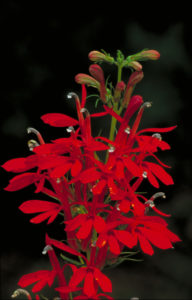
|
Cardinal FlowerHeight: 1 m
Cardinal Flower is an attractive herbaceous perennial wildflower that can grown up to 1 m tall. The leaves are mostly basal, dark green, lance shaped, alternately arranged, and have finely toothed margins. The flowers are showy, bright cardinal red colored, tubular with five lips, appear on an erect terminal spike, and bloom between July and September. The flowers are beneficial for pollinator species, like butterflies and hummingbirds. This is a popular plant choice for wet shoreline properties because of its visual appeal and ornamental value.
|
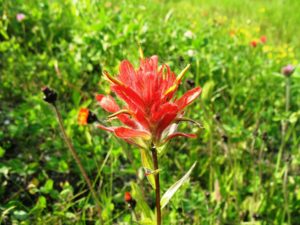
|
Indian PaintbrushHeight: 0.5 m
Indian paintbrush is a biennial wildflower that typically grows less than 0.5 m in height. It usually consists of a basal rosette the first year and produces a flowering stalk the second year. The central stem is usually green or reddish brown and covered in small hairs. The leaves are alternately attached, stemless, medium green coloured, have entire margins, are lance shaped, and are deeply divided into 3-5 lobes, becoming smaller as they ascend the stem. The actual flower of the plant is small, yellowish green in colour, and hidden within the large, showy, fan shaped, reddish orange coloured, bracts. The colouring on the bracts look as though they have been dipped in paint, giving the plant its common name. Since this wildflower has no surface for insects to land, it primarily attracts pollinators that can hover, such as Hoverflies and Hummingbirds. The roots of this plant are unique in the way they help to prevent erosion, as it is a partially parasitic plant. Roots grow until they touch the roots of other plants, frequently grasses, and then penetrate the roots of these host plants to obtain a portion of their nutrients. This creates a more intricate root system with other plants around that helps prevent surface soil erosion. However, this rooting ability makes Indian Paintbrush respond poorly to being transplanted.
|
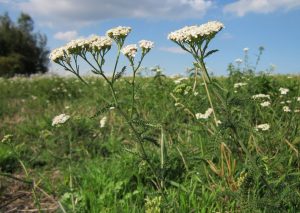
|
YarrowHeight: 0.5 m
Yarrow is a small perennial wildflower species that can grow up to 0.5 m in height. The leaves are dark green coloured, pinnately compound, aromatic when crushed, and are feather-shaped, resembling a fern. The flowers are small, creamy white coloured, have yellow honeycomb centers, appear in wide clusters, and bloom between June and September. This flower blooms for long periods. This wildflower spreads well and can be used to naturalize un-vegetated areas.
|
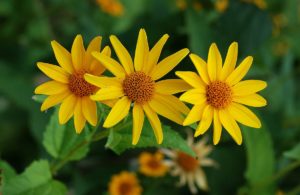
|
Sweet OxeyeHeight: 2m
Sweet Oxeye, also known as False Sunflower, is an attractive, herbaceous, perennial wildflower, which can grow to almost 2 m tall. The flowers are perched atop a stiff stem, with a brownish-yellow center cone surrounded by bright yellow to orange rays. Leaves are 5-12 cm long and 2-8 cm wide, oppositely arranged along the stem, ovate to lanceolate in shape, and have a toothed margin. This wildflower grows best in moist, well-drained soils, preferring full sun, but will tolerate partial shade. Some common natural habitats for the Sweet Oxeye are prairies, meadows, forest edges, and stream banks. Sweet Oxeye is drought tolerant so could be planted in difficult dry sites, but will grow best with regular watering. A large variety of insect species are attracted to the Sweet Oxeye, making it a great addition to a habitat garden.
|
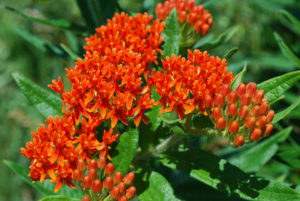
|
Butterfly MilkweedHeight: 0.5 m
Butterfly Milkweed is a very attractive perennial wildflower that typically grows about 0.5 m tall. This plant may also be known by the common name Showy Milkweed. The leaves are green coloured, alternately arranged, narrow and lance-shaped, and have entire margins. The flowers are showy, fragrant, bright orange coloured, have five tiny petals, appear in clusters of 8-25, and bloom between June and August. Butterfly Milkweed is easy to grow and is low maintenance. This wildflower spreads well and can be used to naturalize un-vegetated areas. The roots can be useful for controlling erosion and stabilizing shorelines. The flowers are beneficial to pollinator species, like bees and butterflies. It is also a larval host for caterpillars of the endangered Monarch Butterfly, thus planting this species where possible can help protect this at risk species.
|
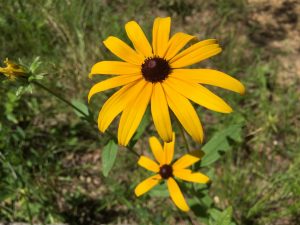
|
Black-Eyed SusanHeight: 1 m
Black-Eyed Susan is a popular biennial or a short-lived perennial wildflower species that typically grows about 1 m in height. Its leaves are green, alternately arranged, lance shaped, and covered with bristly hairs giving the leaf a grey/green colour. The flowers are daisy-like, have 8-20 yellow ray florets surrounding numerous dark brown disk florets, and blooms between June and September. The flowers are beneficial to pollinator species, like bees and butterflies. The seeds are also beneficial to wildlife species, like birds and small mammals. This flower blooms for long periods.
|
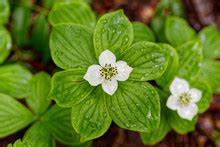
|
BunchberryHeight: 15 cm
Bunchberry is a deciduous ground cover species that can grow around 15 cm in height. This plant may also be known by the common name Creeping-Dogwood. The leaves are deep green, oppositely arranged, oval shaped, and glossy. The flowers are showy, white colored, and bloom between May and June. These flowers produce bright red berries that are edible to humans and beneficial to wildlife species, like birds and small mammals.
|
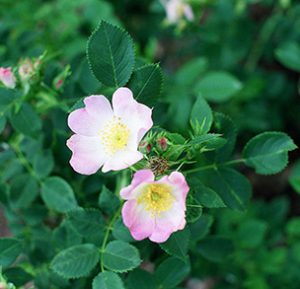
|
Smooth Wild RoseHeight: 1.5m
The Smooth Wild Rose is a shrub species that grows about 1.5 m tall. The name is derived from the fact that it is almost thornless with only a few sharp thorns present near its base. This native shrub is best known for producing beautiful pale pink flowers with five saucer-like petals surrounding a yellow center. The Smooth Wild Rose produces bright red rose hip fruiting bodies which develop during the summer and persist throughout the winter. Leaves produced are alternate and compound, consisting of 5-7 serrated, egg-shaped leaflets.
|
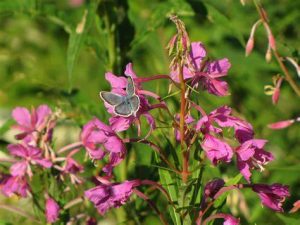
|
FireweedHeight: 1.5 m
Fireweed is a perennial wildflower species that grow up to 1.5 m in height. The stem is smooth, round, and turns from green to red towards the top of the plant. The leaves are light green coloured, alternately arranged, narrow and lance shaped, similar to Willow leaves, have a prominent central vein, and have entire margins. The flowers are showy, purple to pink coloured, have four petals and four sepals, appear at the top of the stem, and bloom between June and September. The flowers are replaced with seedpods that split into multiple sections, beginning at their tips and curling backward, releasing tiny seeds with small tufts of white hair. The flowers are beneficial to pollinator species, like bees and butterflies. This wildflower spreads well and can be used to naturalize un-vegetated areas. The roots can be useful for controlling erosion and stabilizing shorelines. Fireweed gets its name due to its ability to quickly colonize areas recently burned by fire.
|
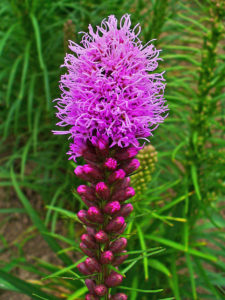
|
Dense Blazing StarHeight: 30-60 cm
Dense Blazing Star is a tall clump-forming perennial wildflower species that can grow between 30 and 60 cm. It has an erect central stem (no branching) that is smooth and purplish/green with many grass-like leaves circulating alternately around it. The leaves are long, narrow, and hairy with one noticeable central vein. This plant is very noticeable when in bloom as it has a wand-like spike of purplish/pink flowers at the top of the central stem. The flowers consist of 4-10 disk florets with a tubular corolla that opens up to 5 spreading star-like lobes and a deeply split protruding style. It prefers moist, well-drained areas such as meadows, moist fields, and along river of lake shorelines. It attracts lots of butterflies and pollinators, as well as mammals such as deer and rabbits. Unfortunately, Dense Blazing Star is listed as threatened under SARA in Ontario. It's main threat is habitat loss due to urban development and habitat alteration. It only naturally occurs in southwestern Ontario with 11-13 known populations. Therefore, this is a great species to plant in suitable areas in Ontario to help protect a threatened species.
|
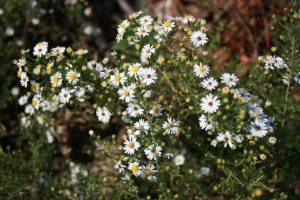
|
White Heath AsterHeight: 1 m
White Heath Aster is a small wildflower species which can grow up to 1 m tall. This plant has a small, dense, heath-like appearance. It has green to grey, hairy stems with numerous alternate, stemless leaves. Its upper leaves are linear, 1-6 cm long, and have a spine tip. The lower leaves are broadly lanceolate and typically fall off by the time the flowers bloom. At the tops of the stems are short wand-like clusters of small white flowers. Each flower has 12 white ray florets surrounding numerous yellow disk florets. There are also many needle-shaped green bracts along the stem. The flowers give way to small seeds with tufts of hair to help in dispersal as it spreads via seeding and by rhizomatous roots. This wildflower species attracts butterflies and bees, as well as wild turkeys, deer, and rabbits.
|
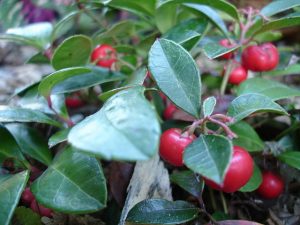
|
WintergreenHeight: 15 cm
Wintergreen is a medium-sized ground cover species that grows up to 15 cm in height. The leaves are glossy, dark-green, simple, oval shaped, and turn purple during the fall. Wintergreen is a visually appealing plant that produces small, white, bell-shaped flowers during the spring. This species yields edible, scarlet red berries during July, which persist throughout the winter months. These berries are a great food source for many song birds, squirrels, deer and a tasty treat for humans when added to pastries or salads. The name Wintergreen comes from the plants ability to keep it's leaves throughout the winter. Wintergreen is unique because their leaves emit a minty aroma when crushed. Wintergreen oil is commonly used in the flavoring of gum and toothpaste.
|
Compartment A
Naturalization Area
 pH: basic
pH: basic Depth: potted
Depth: potted-
 Moisture: dry
Moisture: dry -
 Soil Type: clay
Soil Type: clay  Plant Height: max 1.5m, any
Plant Height: max 1.5m, any-
 Light conditions: partial sun
Light conditions: partial sun
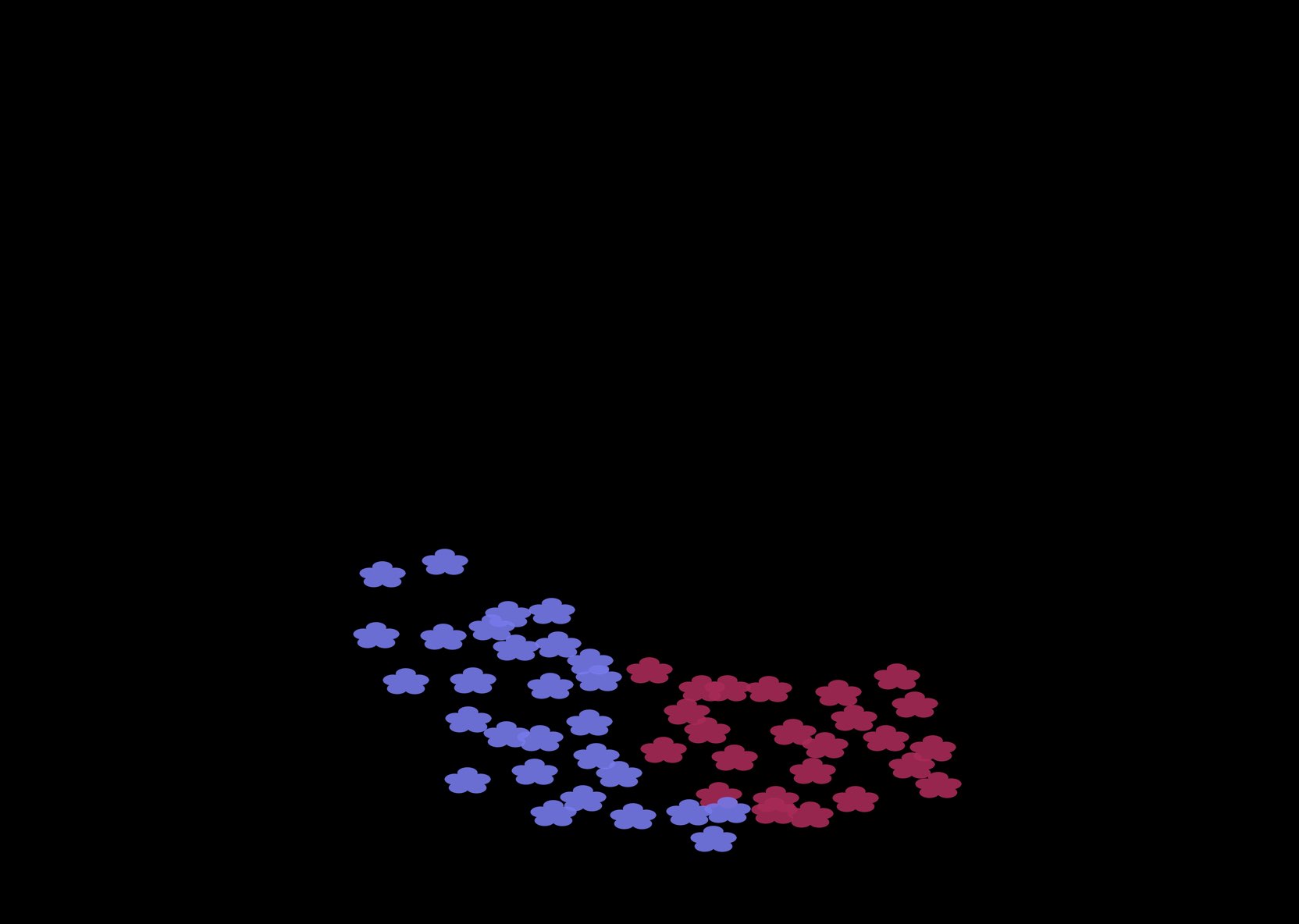
Compartment B
Naturalization Area
Red orange yellow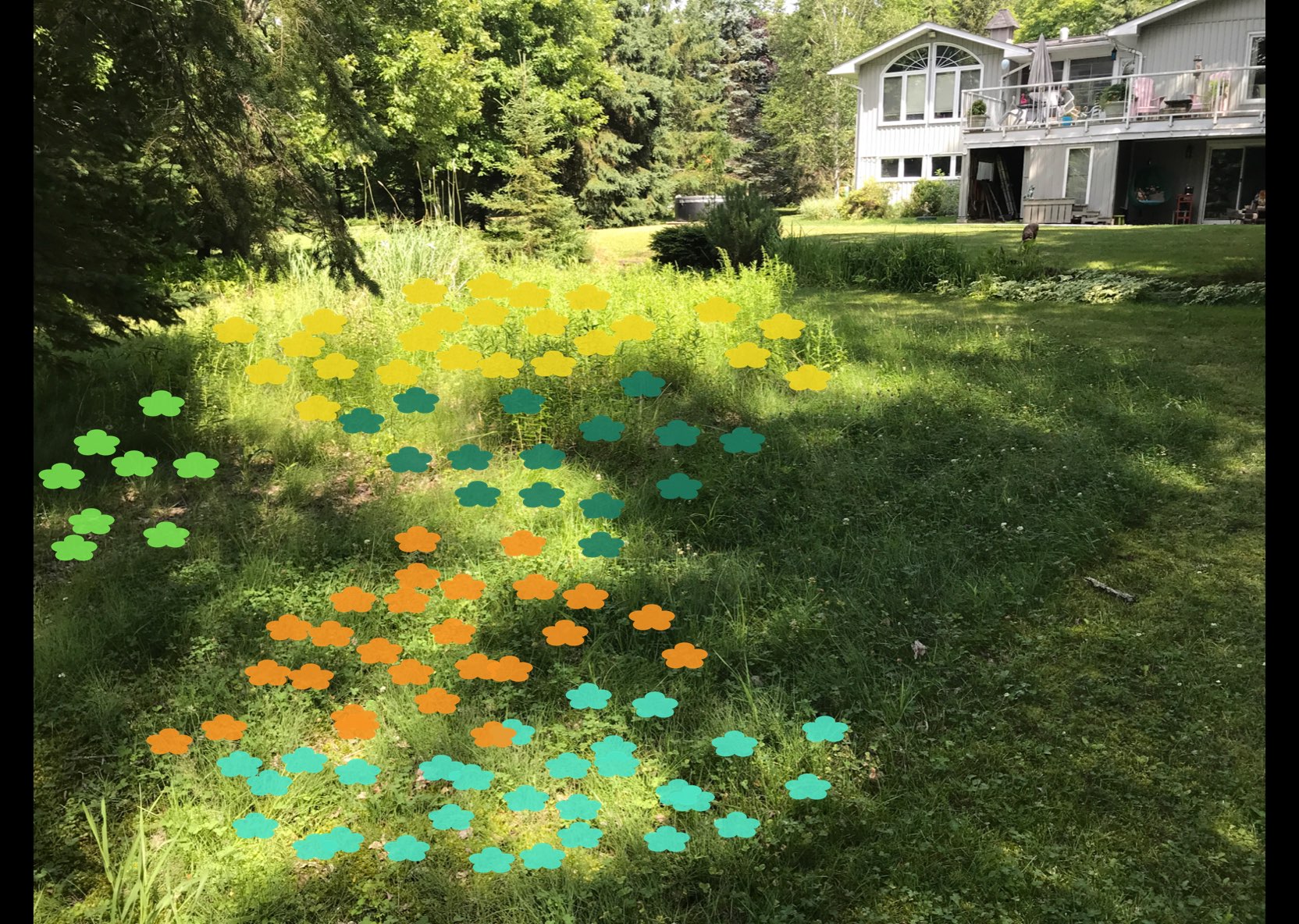
Compartment C
Naturalization Area
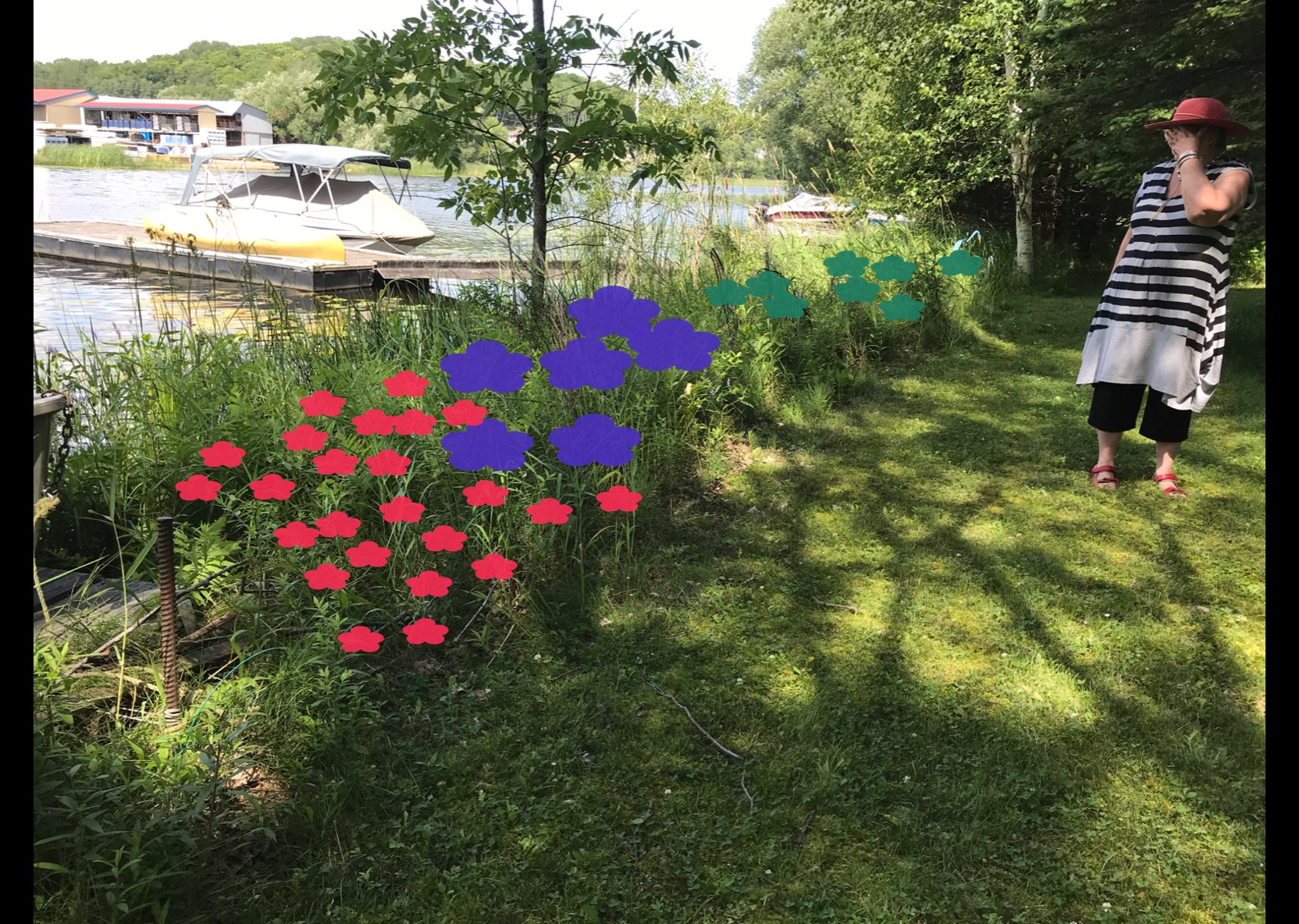
Compartment D
Naturalization Area
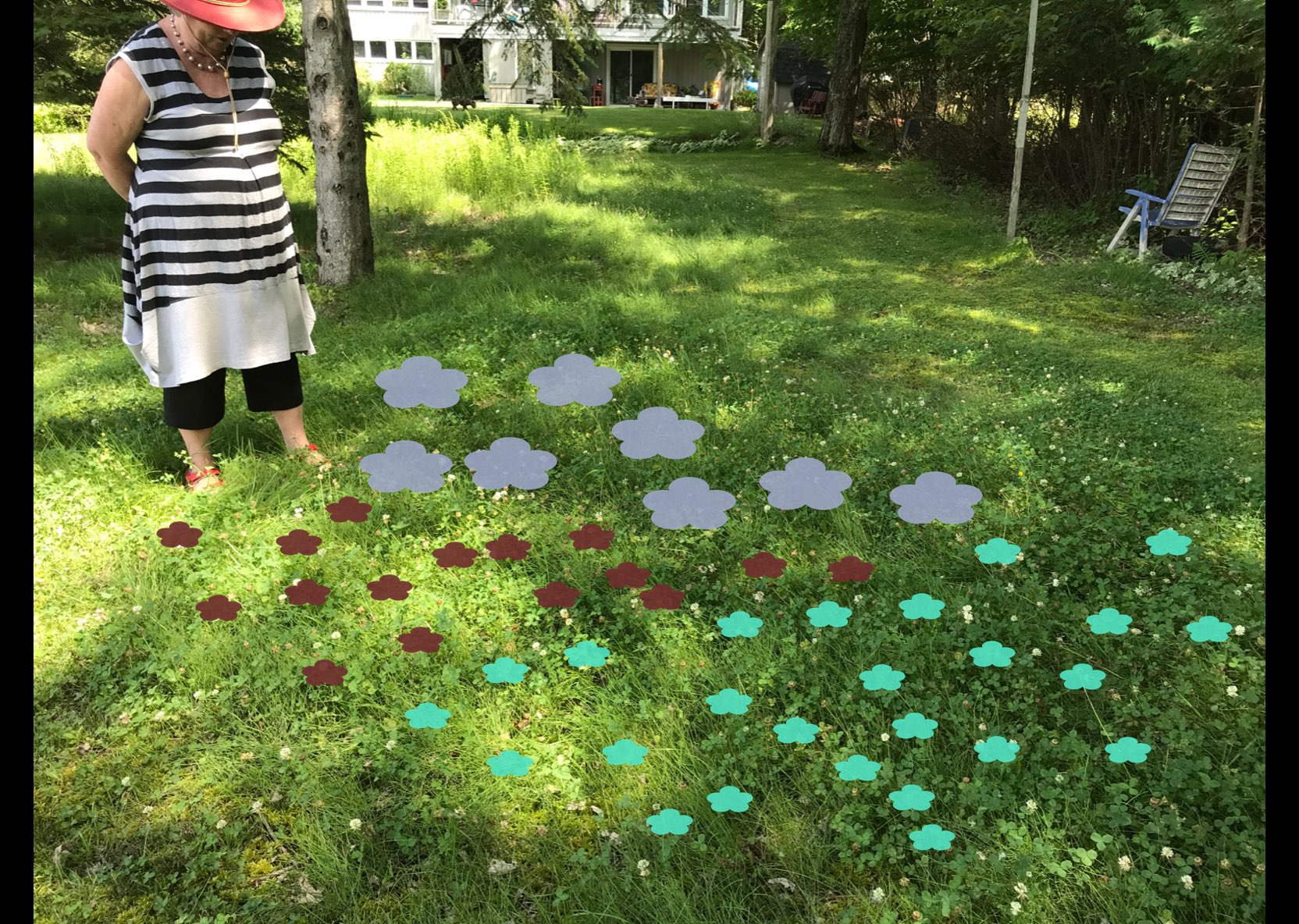
Compartment E
Naturalization Area
Wild ginger in outlined area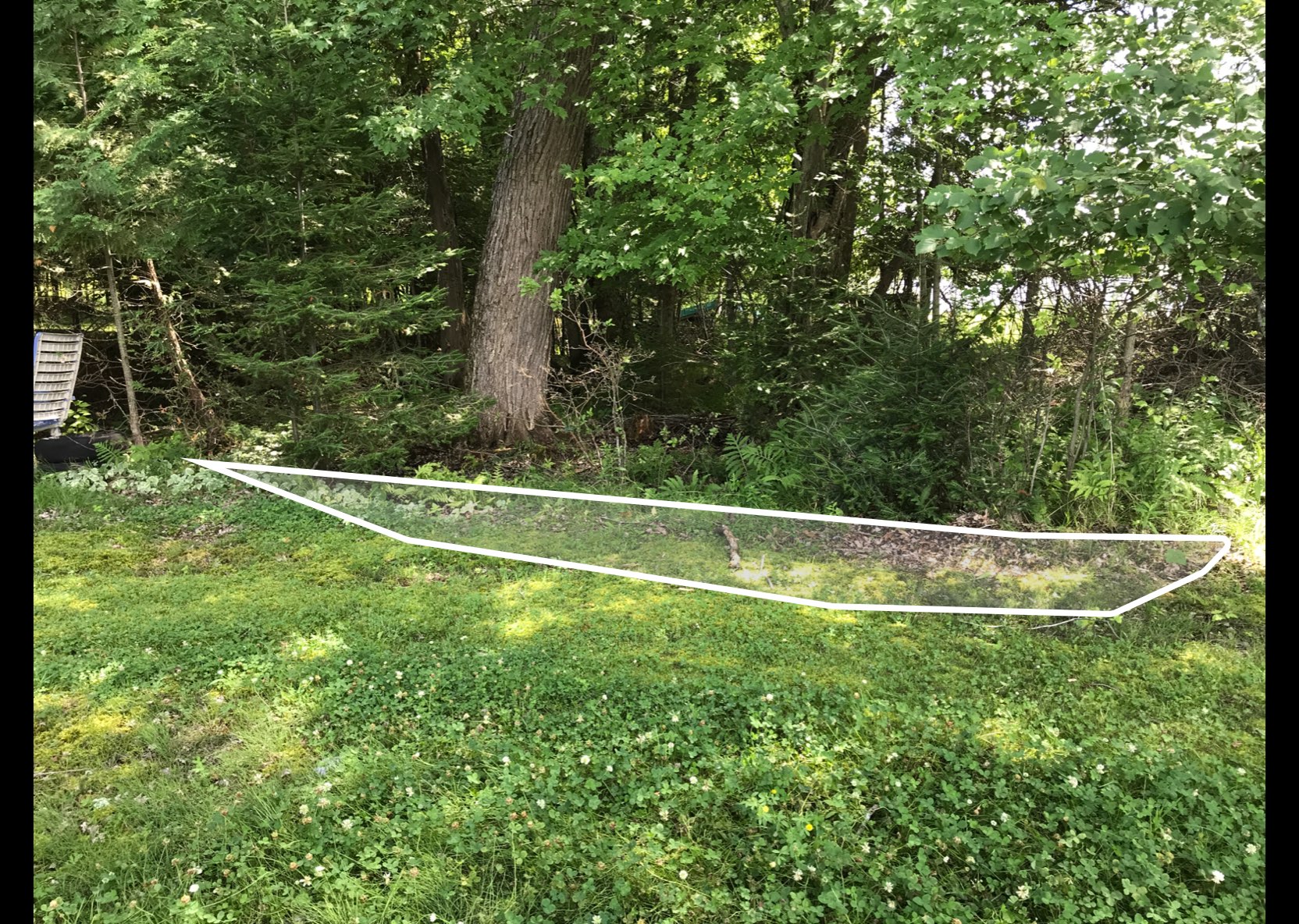
Compartment F
Naturalization Area
wild blue Phlox in outlined area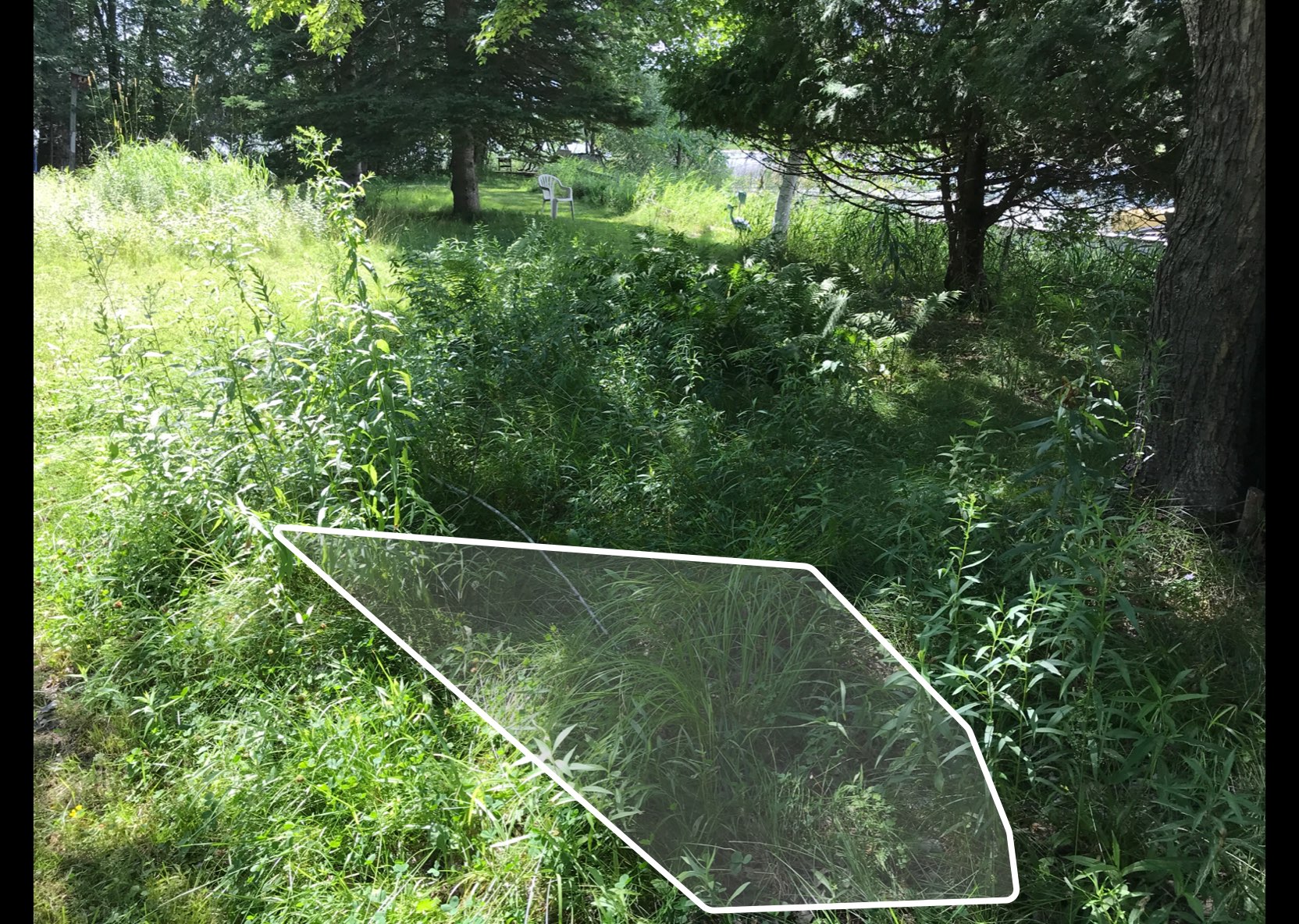
Compartment G
Naturalization Area
Wild ginger in outlined area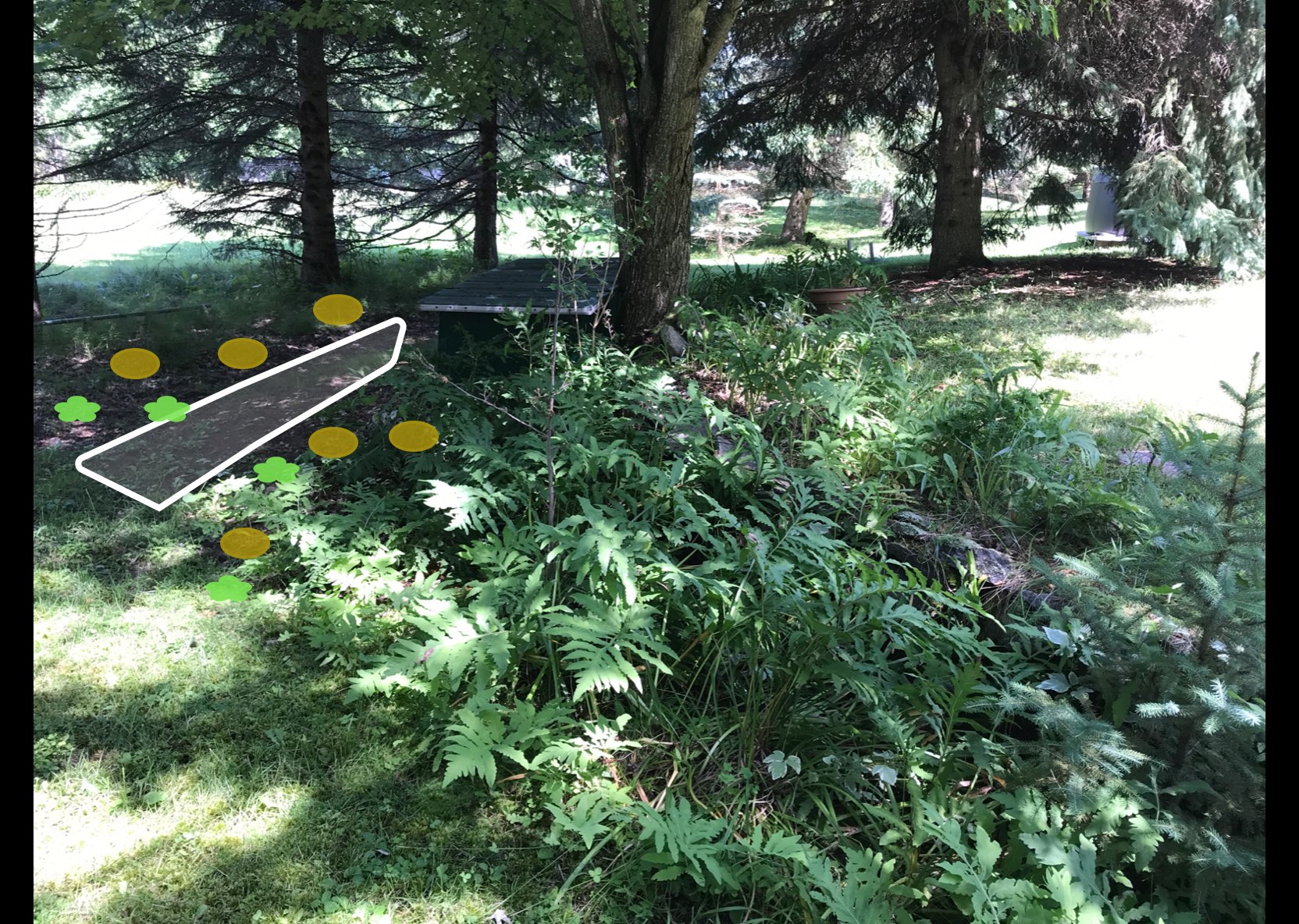
Schedule B
Financial Summary
Project by: The Land Between
Shoreline Re-Naturalization Starter Kit includes: free site visit, customized re-naturalization planting plan for your shoreline property, native plants including free bare root (small) and potted (large) plants and wildflowers, coconut fibre pads to deter grass from growing around new plantings, tree guards for all deciduous trees, mulch for your wildflowers, Plant Care Guide with instructions on how to take care of your new plants, Habitat Creation Guide and a Wildflower Garden Guide.
Our planting plans are created onsite with you and provide detailed information and plans to re-naturalize your shoreline property. We take photos of areas for planting and overlay native plants that are well suited to your property based on site conditions such as soil type and sunlight availability.
We will work with you to create a plan that works for you including options for low growing plants in areas where views are important.
| Item | Quantity | Cost/Item | Subtotal |
|---|---|---|---|
| Starter Kit fee | $250 | ||
| Free potted plants | 6 | $0 | $0 |
| Free bareroot plants | 0 | $0 | $0 |
| Free wildflowers | 25 | $0 | $0 |
| Paid wildflowers | 220 | 7.00 | 1540.00 |
| Total costs | 1790.00 |
Schedule C
Project Agreement
Stewardship Agreement
Please indicate your agreement to this proposed plan by signing the following Stewardship Agreement and submitting it, along with your financial contribution, to:
The Land Between
Box 1368, Haliburton, Ontario, K0M 1S0
Plant Availability
Please note that plant species may need to be changed based on plant stock availability at the time of ordering.
Project Completion
Upon receiving your signed stewardship agreement and financial contribution, a date will be booked for you to pick up your Natural Edge Kit. The Land Between will supply all plants and materials. If you are paying for the planting to be completed for you, a date will be arranged for The Land Between to plant your shoreline, bringing the plants and materials with them. If there are particular dates that you would prefer, we will do our best to accommodate your requests.
The Natural Edge Stewardship Agreement with The Land Between
Agreement made this Day of the Month of in the Year .
BETWEEN John Rosalie and Coco Cowan (Hereinafter called the OWNERS)
AND The Land Between Box 1368, Haliburton, Ontario, K0M 1S0 (Hereinafter called TLB)
WHEREAS the Owners and TLB have met and discussed plans for shoreline naturalization on the specified area(s) in Schedule A existing on the Owners’ land;
WHEREAS the Owners indicate approval of the project as proposed; and
WHEREAS the project is, or will be for the benefit of the Owners and others;
NOW THEREFORE THE PARTIES AGREE AS FOLLOWS:
1. This Agreement shall be in effect for a period of 5 years, commencing with the date of this Agreement.
2. The Owners and TLB agree that the areas where the work is to be performed is as described in Schedule A.
3. The Owners agree to pick up their Natural Edge Starter Kit from TLB’s office and plant their shoreline within two days of receipt. The Owners will provide “after” photos of the work completed to be used for reporting purposes. If the Owners wish to have the planting completed for them, then TLB or it’s contractors, employees and agents will complete the planting at cost, as indicated in Schedule B.
4. If the planting is to be completed by TLB, then the Owners grant TLB, its contractors, employees and agents, the right to enter the property to perform the work agreed upon as outlined in Schedule A. In addition, TLB, its contractors, employees and agents may inspect the work performed for the purposes of monitoring the project and survival assessment, with prior agreement with Owners for date and time of inspection.
5. The Owners agree to contribute the “Landowner contribution” and pay the costs indicated in Schedule B.
6. In instances where the Owners are to pay TLB for work to be performed (outlined in Schedule A), the Owners agree to provide payments to TLB prior to the commencement of that operation. Failure of payment shall constitute a breach of this Agreement and the Owners agree that this Agreement will be terminated and thereupon the Owners agree to pay TLB the estimated costs of the operations of the project completed to date, if any.
7. The Owners agree, if necessary, to perform a reasonable amount of maintenance, which is described in the Native Plant Care Guide, available at naturaledge.watersheds.ca.
8. If a contractor is required to perform the work outlined in Schedule A, then the contractor carrying out the work on the land described will be required to take out and furnish evidence of a comprehensive policy of public liability and property damage coverage. The contractor and their workers will be required to be in good standing with the Workplace Safety and Insurance Board (WSIB) prior to performing the work.
9. The Owners agree not to remove, destroy or alter the project without prior consultation and approval of TLB. Pruning and trimming planted nursery stock, or adding replacement native nursery stock is exempt.
10. The Owners agree not to mow the planted area.
11. The Owners do acknowledge that TLB, its contractors, employees and agents, having performed said works, are not under further obligation with respect to survival of nursery stock, inspection, or maintenance.
12. The Owners, in the absence of negligence, hereby remise, release and forever discharge TLB, its contractors, employees and agents from all claims and demands for injuries, including death, loss, damages and costs in any way related to or connected with installation and maintenance of the work described or resulting from any deleterious effects of the work to the land or to the lands and buildings thereon retained by the Owners.
IN WITNESS WHEREOF the parties have agreed to the contents of this plan; SIGNED:
About this program
About The Land Between
The Land Between is Cottage Country's Conservation Organization. We are a grassroots non-govermennt organization that works to preserve and restore the natural, cultural and socio-economic features of this unique and irreplaceable region in Ontario
This program was created by Watersheds Canada
We believe that every person has the right to access clean and healthy lakes and rivers in Canada. At Watersheds Canada, we work to keep these precious places naturally clean and healthy for people and wildlife to continue using for years to come. We love working with others to meet the needs of local communities, whether you’re a concerned citizen, a landowner, a lake association looking for help, or a coalition of groups interested in activating your local community.

